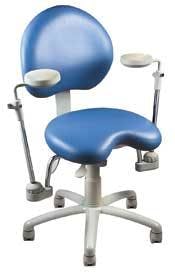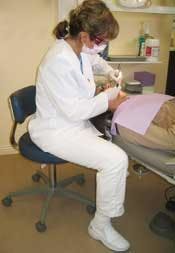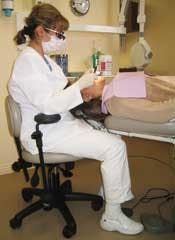Elbow Room
Free-motion elbow supports could be a key to reducing musculoskeletal disorders among dental hygienists.
by Tricia Osuna, RDH, BS, FAADH
Many dental hygiene professionals realize that undiagnosed and untreated injuries caused by ergonomically unsound practices are often the cause of physical pain and early retirement. Numerous strategies are employed to prevent the injuries. Dental hygienists are trained to provide care from a seated position, which is different from earlier training that allowed for standing only. In addition, such things as improved lighting, magnification, and chairs that support proper posture have been introduced. Another technology, free-motion elbow supports, recently emerged to help protect us.
As an important study showed, once we focus on ourselves and what we do to our bodies, we can sense something out of the ordinary. We investigate options to alleviate and hopefully prevent pain, and return to an ergonomically friendly practice routine. In this article, you will read information from the study on the use of elbow supports that reviews problems of musculoskeletal disorders among dental hygienists. The benefits of adding free-motion elbow supports to our ergonomic armamentaria will be enumerated. The incidence of musculo-skeletal disorders (MSDs) among dental hygienists has increased noticeably during the past 10 years. While results vary, questionnaire data indicates that from 63% to as many as 95% of dental hygienists report general musculoskeletal pain in one or more areas, including lower back, shoulder, neck, arm, wrist, and hand.1 These MSDs frequently cause hygienists to have difficulty performing their work, loss of work time, and reduced quality of life outside of work.
While different factors may contribute to MSDs, they are overwhelmingly caused by job-related conditions. Hygienists' work in awkward positions and hold those positions for long periods of time. Many MSDs, especially those involving the neck and shoulders, result from prolonged static posture. Postural factors include positioning the patient so that the hygienist must sit in a way that stresses the neck, shoulders, and lower back.
Also, the high percentage of maximum voluntary contraction (MVC) muscles required for many hygiene procedures contributes greatly to the high incidence of MSDs. When muscles are required to contract strenuously for extended periods of time, blood circulation is impeded and oxygen flow is reduced. This in turn causes a buildup of lactic acid in the muscles, and muscle fatigue leading to MSD results.
There have been numerous studies of MSDs among dental hygienists during the past decade. Most of them, though, have relied heavily on observation and questionnaire results.2 This has two consequences. First, the data tends to be highly subjective, often depending on the perceptions of individual subjects in the studies, as well as those conducting the study. Second, it often leads to broad conclusions and recommendations, and these are difficult to interpret for each individual dental practitioner.
This article reviews the conclusions and recommendations of several studies in light of a recent study3 that used electromyography (EMG) to measure the actual amount of force exerted during key work activities. EMG measures the electrical activity in muscles and determines their level of contraction during specific activities.
The study first measured hygienists' stress levels when performing under normal working conditions and using customary equipment, postures, and techniques. The study found that — even when an ideal posture was maintained — significant muscle stress was observed without the use of free-motion elbow supports. It then followed up those results by testing the same group of hygienists after they were retrained and provided with gel-padded free-motion elbow supports.
The study demonstrates that changing work habits and posture, coupled with seating equipped with the elbow supports, significantly reduces the stress of prolonged static postures and the percentage of MVC of muscles required to perform hygienists' tasks.
Because the study utilized EMG devices attached to subjects to measure the stress on specific muscles, it provides direct evidence based on physiological measurements rather than questionnaires and observation to support its conclusions about the best ways to reduce MSDs. The study's recommendations focus specifically on the need for free-motion elbow supports, which significantly reduce the percentage of MVCs hygienists need to perform their tasks.
Adding free-motion elbow supports, changing the hygienist's physical positioning in relation to the patient, reducing the frequency and range of arm movements away from the body, reducing workload, increasing downtime between patients (in some cases), and adding stretching and flexibility exercises to one's regimen all promise to significantly reduce the incidence of potentially debilitating musculoskeletal disorders for dental hygienists.
How the Study Was Conducted
The study was conducted under the auspices of the Association for Health and Safety in the Workplace, Social Affairs Sector, a Canadian organization based in Montreal that is dedicated to improving working conditions. The study noted that hygienists are required to keep their arms in a position of abduction (held up and away from the body) for long periods of time, especially as they scale and polish teeth. It was designed to measure the stress on the muscles of the shoulder girdle, shoulder, and neck, the key areas exposed to stress during such work activities. The study noted that muscular contraction that exceeds 10% of MVC results in muscle fatigue and imbalance, and the prolonged contraction of muscles at this level can have progressively damaging consequences.
These consequences begin with ischemia, a gradual reduction in the blood supply to the muscles in question. Ischemia frequently leads to the formation of "trigger points," small groups of muscle fibers which remain in a constant state of contraction. If left untreated, these trigger points, which manifest as small painful spots within muscles, can gradually lead to the degeneration of muscle tissue, stiffness, nerve compression, and joint and spinal disk disorders.
The study first used EMG to measure the maximum level of voluntary muscle contraction each of the 10 participants was capable of. Those levels were then compared to the MVC each participant exerted while performing dental hygiene therapy in order to determine the percentage of MVC required to perform the tasks under different conditions. The objective for researchers was to determine whether the percentage of MVC was dangerous to participants. Sustained contraction at levels of 10% or more of MVC have the potential to do long-term damage to muscles and joints, while levels of 5% of MVC or less are generally not considered harmful. Study participants' work activity was first measured as they provided therapy in the normal manner. Each participant was measured while scaling and polishing the teeth of four patients in this way. After the initial measurements were taken, participants were provided with new seating that included gel-padded free-motion elbow supports. They received training for this equipment, and, in some cases, their work routine was altered. These changes included working from behind the patient's head more, changing posture and head position, and making optimal use of the free-motion elbow supports.
After they grew used to these changes, their muscle contraction levels were measured again as they performed the same procedures on four patients. The use of free-motion elbow supports significantly reduced the level of muscle contraction necessary to perform their work. For the trapezius muscle — the large muscle in the upper back that stabilizes the arms and neck and lifts and lowers the shoulders — levels of muscle contraction averaged more than 10% of VMC without the free-motion elbow supports. When free-motion elbow supports were used, those levels dropped to an average of less than 5% of VMC during scaling and polishing for the left trapezius, and to an average of 7.5% for the right (all study participants were right-handed).
Another important result of the study involved the time spent by hygienists in different positions in relation to the patients. With the addition of free-motion elbow supports, and after training in work technique, the hygienists nearly doubled the amount of time they spent positioned behind the patient's head, from 34% to 67%. The time spent positioned at the side of the patient was reduced proportionately. This change in working position was also a factor in the reduction of the stress on muscles.
The free-motion elbow supports enabled hygienists to hold their arms lower and closer to their bodies, significantly reducing abduction. In fact, with the free-motion elbow supports at a lower position, the reduction in MVC was in some cases as high as 80%. The study concluded that the use of free-motion elbow supports led to a significant reduction in the level of muscle contraction relative to MVC while providing dental hygiene therapy. The most significant reduction in MVC occurred in the muscles that stabilize the left shoulder (in right-handed hygienists), but those same hygienists also demonstrated a 25% reduction in MVC in the right shoulder, an important step in preventing long-term negative consequences.
Recommendations
The reduction in static workload measured during the study was the result of several things, centering on the elbow supports. As a result of these findings, the study made the following recommendations:
• Hygienists should consider using free-motion elbow supports as part of their normal work procedure. If the dental practice is considering new chairs for dental hygienists, the movable supports are available on chairs manufactured by the Brewer Company. If hygienists are currently using satisfactory seating which provides adjustable lumbar support and the seat can be tilted to the ideal angle, then free-motion elbow supports can be purchased from Posiflex Design and installed on the chair.
• Hygienists should make sure that the patient's head is positioned higher than usual. This might mean that the hygienist needs to raise the height of the patient chair so that the patient's head is closer to him or her. The patient should be high enough so that the hygienist reduces neck flexion from zero degrees (head straight up) to no more than 20 degrees when leaning over the patient.
In addition, by raising the patient's chair, the hygienist will be able to work with his or her legs under the chair itself, rather than in a position where the legs have to "straddle" the chair. In other words, hygienists should be able to slide their legs under the patient's chair as they work from behind the patient's head in order to prevent awkward and stressful postures that can contribute to muscle contraction levels that are higher than 5% of MVC.
• Hygienists should perform a greater percentage of tasks from the 11, 12, and 1 o'clock positions, rather than from the 8, 9, and 10 o'clock positions. Working from behind the head when the patient's chair is positioned higher and the backrest lower — and the hygienist can slide his or her legs under the patient's chair — provides postural advantages when compared to working from beside the patient.
The free-motion elbow supports enable the hygienist to more easily and naturally do work from behind the patient's head. Hygienists found that the supports actually served as a "reminder" to keep their arms lower as they performed procedures, and they provided support that reduced the need for abduction during those procedures.
• A corollary to the previous recommendation is that during periods greater than 30 seconds of neck flexion, they make sure that the angle of flexion is no greater than 20 degrees. This means that leaning over the patient for long periods of time with the neck flexed up to 75 degrees, as many hygienists do, should be avoided. In addition, working from a more upright position helps the hygienist maintain the proper curve in the lumbar region and thus avoid the lower back problems that frequently occur as a result of incorrect work postures.
Free-motion elbow supports are a key component in reducing work-related musculoskeletal disorders of the back, shoulders, and neck. Because this support is applied at the elbow, it also enables the hygienist to avoid the excessive wrist flexion that can lead to carpal tunnel syndrome, a serious deterrent to the success of a hygienist's career. For more information on Posiflex free-motion elbow supports, contact Posiflex Design at (888) 767-4353, www.posiflexdesign.com, or Brewer Design at (800) 558-8934.
References
1. Sanders M, Turcotte C. Strategies to reduce work-related musculoskeletal disorders in dental hygienists: Two case studies. Journal of Hand Therapy. Philadelphia: 2002;15:363-75.
2. Akesson I, Johnson B, Rylander L, Moritz U. Musculoskeletal disorders among female dental personnel — clinical examination and a 5-year follow-up study of symptoms. Int. Arch Occup Environ Health. 1999; 72:395-403.
3. Proteau RA, Marchand D. Reducing musculoskeletal strain with the use of mobile gel-padded elbow-rests in a dental clinic. Proceedings of the SELF-ACE Conference on Ergonomics for Changing Work, October 2001; Proteau RA. Prevention of work-related musculoskeletal disorders (MSDs) in dental clinics. Association for health and safety in the workplace, social affairs sector (ASSTSAS), January 2004.
About the Author
Tricia Osuna, RDH, BS, FAADH, is a clinician, educator, author, consultant, public speaker, and business owner. Her company, Professional Insights, Inc., provides market research, product evaluations and consulting services. An active member of ADHA, she is the current president elect of the American Academy of Dental Hygiene, as well as past president of the California Dental Hygienists' Association. Tricia can be contacted at [email protected].





